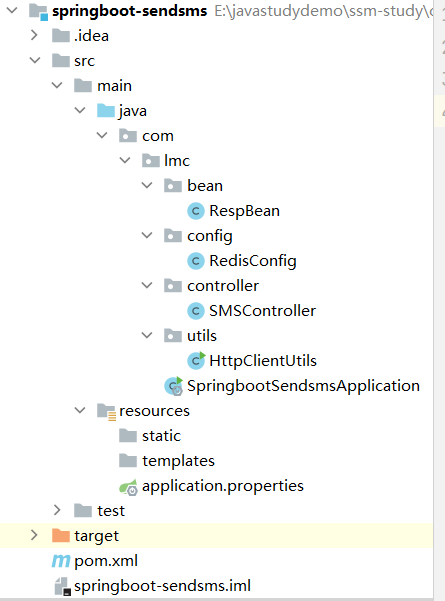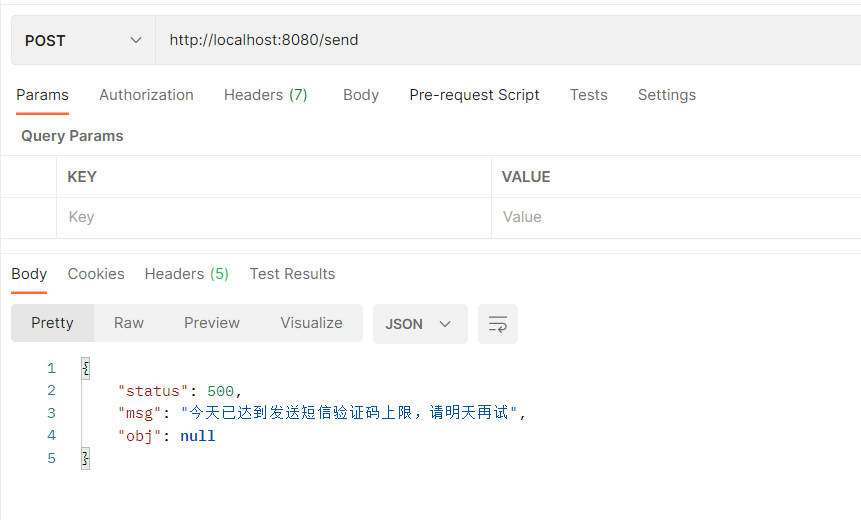Java实现发送短信验证码+redis限制发送的次数功能
java实现短信验证码发送,由于我们使用第三方平台进行验证码的发送,所以首先,我们要在一个平台进行注册。这样的平台有很多,有的平台在新建账号的时候会附带赠几条免费短信。这里我仅做测试使用(具体哪个平台见参考三,很简单,注册账号就行,记得添加短信签名)。
另外,在实际项目中,如果有人恶意攻击,不停的发送短信验证码,就会造成很大的损失。故对发送次数做一定的限制就非常必要,这里我们限制一个手机号一天可以发多少短信和短信平台无关。
这里采用的是存redis来实现这一个功能。就是每次调用发送验证码这个接口都会判断手机号码是否在redis中存为key了。如果没有则创建一个key为手机号码value是1.因为redis中不支持数字所以将其变为了string类型。如果redis中已经有这个key了则将此key的值取出来加1再存进redis中。
代码实现:
pom.xml
<?xml version="1.0" encoding="UTF-8"?>
<project xmlns="http://maven.apache.org/POM/4.0.0" xmlns:xsi="http://www.w3.org/2001/XMLSchema-instance"
xsi:schemaLocation="http://maven.apache.org/POM/4.0.0 https://maven.apache.org/xsd/maven-4.0.0.xsd">
<modelVersion>4.0.0</modelVersion>
<parent>
<groupId>org.springframework.boot</groupId>
<artifactId>spring-boot-starter-parent</artifactId>
<version>2.6.2</version>
<relativePath/> <!-- lookup parent from repository -->
</parent>
<groupId>com.lmc</groupId>
<artifactId>springboot-sendsms</artifactId>
<version>0.0.1-SNAPSHOT</version>
<name>springboot-sendsms</name>
<description>Demo project for Spring Boot</description>
<properties>
<java.version>1.8</java.version>
</properties>
<dependencies>
<dependency>
<groupId>org.springframework.boot</groupId>
<artifactId>spring-boot-starter-web</artifactId>
</dependency>
<dependency>
<groupId>org.springframework.boot</groupId>
<artifactId>spring-boot-starter-test</artifactId>
<scope>test</scope>
</dependency>
<dependency>
<groupId>org.apache.httpcomponents</groupId>
<artifactId>httpclient</artifactId>
</dependency>
<dependency>
<groupId>org.springframework.boot</groupId>
<artifactId>spring-boot-starter-data-redis</artifactId>
</dependency>
</dependencies>
<build>
<plugins>
<plugin>
<groupId>org.springframework.boot</groupId>
<artifactId>spring-boot-maven-plugin</artifactId>
</plugin>
</plugins>
</build>
</project>
RespBean.java
package com.lmc.bean;
public class RespBean {
private Integer status;
private String msg;
private Object obj;
public static RespBean build() {
return new RespBean();
}
public static RespBean ok(String msg) {
return new RespBean(200, msg, null);
}
public static RespBean ok(String msg, Object obj) {
return new RespBean(200, msg, obj);
}
public static RespBean error(String msg) {
return new RespBean(500, msg, null);
}
public static RespBean error(String msg, Object obj) {
return new RespBean(500, msg, obj);
}
private RespBean() {
}
private RespBean(Integer status, String msg, Object obj) {
this.status = status;
this.msg = msg;
this.obj = obj;
}
public Integer getStatus() {
return status;
}
public RespBean setStatus(Integer status) {
this.status = status;
return this;
}
public String getMsg() {
return msg;
}
public RespBean setMsg(String msg) {
this.msg = msg;
return this;
}
public Object getObj() {
return obj;
}
public RespBean setObj(Object obj) {
this.obj = obj;
return this;
}
}
RedisConfig.java
package com.lmc.config;
import com.fasterxml.jackson.annotation.JsonAutoDetect;
import com.fasterxml.jackson.annotation.PropertyAccessor;
import com.fasterxml.jackson.databind.ObjectMapper;
import org.springframework.boot.autoconfigure.condition.ConditionalOnMissingBean;
import org.springframework.context.annotation.Bean;
import org.springframework.context.annotation.Configuration;
import org.springframework.data.redis.connection.RedisConnectionFactory;
import org.springframework.data.redis.core.RedisTemplate;
import org.springframework.data.redis.core.StringRedisTemplate;
import org.springframework.data.redis.serializer.Jackson2JsonRedisSerializer;
import java.net.UnknownHostException;
@Configuration
public class RedisConfig {
@Bean
@ConditionalOnMissingBean(name = "redisTemplate")
public RedisTemplate<String, Object> redisTemplate(
RedisConnectionFactory redisConnectionFactory)
throws UnknownHostException {
Jackson2JsonRedisSerializer<Object> jackson2JsonRedisSerializer = new Jackson2JsonRedisSerializer<Object>(Object.class);
ObjectMapper om = new ObjectMapper();
om.setVisibility(PropertyAccessor.ALL, JsonAutoDetect.Visibility.ANY);
om.enableDefaultTyping(ObjectMapper.DefaultTyping.NON_FINAL);
jackson2JsonRedisSerializer.setObjectMapper(om);
RedisTemplate<String, Object> template = new RedisTemplate<String, Object>();
template.setConnectionFactory(redisConnectionFactory);
template.setKeySerializer(jackson2JsonRedisSerializer);
template.setValueSerializer(jackson2JsonRedisSerializer);
template.setHashKeySerializer(jackson2JsonRedisSerializer);
template.setHashValueSerializer(jackson2JsonRedisSerializer);
template.afterPropertiesSet();
return template;
}
@ConditionalOnMissingBean(StringRedisTemplate.class)
public StringRedisTemplate stringRedisTemplate(
StringRedisTemplate template = new StringRedisTemplate();
}
SMSController.java
package com.lmc.controller;
import com.lmc.bean.RespBean;
import com.lmc.utils.HttpClientUtils;
import org.springframework.beans.factory.annotation.Autowired;
import org.springframework.data.redis.core.RedisTemplate;
import org.springframework.data.redis.core.StringRedisTemplate;
import org.springframework.web.bind.annotation.RequestMapping;
import org.springframework.web.bind.annotation.RestController;
import java.util.Calendar;
import java.util.HashMap;
import java.util.Map;
import java.util.concurrent.TimeUnit;
/**
* @description:
* @Author: lmc
* @date: 2021/12/26 10:21
*/
@RestController
public class SMSController {
@Autowired
StringRedisTemplate stringRedisTemplate;
@RequestMapping("/send")
public RespBean sendSMS() {
String Uid = "xxxxxxxx";
String Key = "xxxxxxxxxxxxxxx";
String smsMob = "xxxxxxxxx";
String sendSMSCount = "sendSMSCount:" + smsMob;
if ("2".equals(stringRedisTemplate.opsForValue().get(sendSMSCount))) {
return RespBean.error("今天已达到发送短信验证码上限,请明天再试");
}
//短信内容
String smsText = "欢迎使用xx系统,验证码:8888";
Map maps = new HashMap();
maps.put("Uid", Uid);
maps.put("Key", Key);
maps.put("smsMob", smsMob);
maps.put("smsText", smsText);
String result = HttpClientUtils.sendHttpPost("http://utf8.sms.webchinese.cn", maps);
int i = Integer.parseInt(result);
if (i > 0) {
if (stringRedisTemplate.opsForValue().get(sendSMSCount) == null) {
stringRedisTemplate.opsForValue().set(sendSMSCount, "1", getEndTime(), TimeUnit.MILLISECONDS);
} else {
String value = stringRedisTemplate.opsForValue().get(sendSMSCount);
int times = Integer.parseInt(value) + 1;
String timesStr = String.valueOf(times);
stringRedisTemplate.opsForValue().set(sendSMSCount, timesStr, getEndTime(), TimeUnit.MILLISECONDS);
}
return RespBean.ok("发送成功");
return RespBean.ok("发送失败");
}
//获取当前时间到今天结束时间所剩余的毫秒数:
public static long getEndTime() {
//获取当前时间的毫秒数
long time = new java.util.Date().getTime();
//获取到今天结束的毫秒数
Calendar todayEnd = Calendar.getInstance();
todayEnd.set(Calendar.HOUR_OF_DAY, 23); // Calendar.HOUR 12小时制。HOUR_OF_DAY 24小时制
todayEnd.set(Calendar.MINUTE, 59);
todayEnd.set(Calendar.SECOND, 59);
todayEnd.set(Calendar.MILLISECOND, 999);
long endTime = todayEnd.getTimeInMillis();
//这里endTime-time获取的是到23:59:59:999的毫秒数。再加1才是到24点整的毫秒数
return endTime-time+1;
}
HttpClientUtils.java(HttpClient工具类,可以复用)
package com.lmc.utils;
import java.io.IOException;
import java.net.URL;
import java.util.ArrayList;
import java.util.HashMap;
import java.util.List;
import java.util.Map;
import org.apache.http.NameValuePair;
import org.apache.http.client.config.RequestConfig;
import org.apache.http.client.entity.UrlEncodedFormEntity;
import org.apache.http.client.methods.CloseableHttpResponse;
import org.apache.http.client.methods.HttpGet;
import org.apache.http.client.methods.HttpPost;
import org.apache.http.client.methods.HttpRequestBase;
import org.apache.http.conn.ssl.DefaultHostnameVerifier;
import org.apache.http.conn.util.PublicSuffixMatcher;
import org.apache.http.conn.util.PublicSuffixMatcherLoader;
import org.apache.http.entity.ContentType;
import org.apache.http.entity.StringEntity;
import org.apache.http.impl.client.CloseableHttpClient;
import org.apache.http.impl.client.HttpClients;
import org.apache.http.impl.conn.PoolingHttpClientConnectionManager;
import org.apache.http.message.BasicNameValuePair;
import org.apache.http.util.EntityUtils;
import org.slf4j.Logger;
import org.slf4j.LoggerFactory;
public class HttpClientUtils {
private static Logger logger = LoggerFactory.getLogger(HttpClientUtils.class);
// 链接相关参数
private static int socketTimeout = 15000;
private static int connectTimeout = 15000;
private static int connectionRequestTimeout = 15000;
private static RequestConfig requestConfig = null;
// 连接池相关参数
private static int connMgrMaxTotal = 100;
private static int connMgrMaxPerRoute = 50;
private static PoolingHttpClientConnectionManager connMgr = null;
static {
requestConfig = RequestConfig.custom().setSocketTimeout(socketTimeout).setConnectTimeout(connectTimeout).setConnectionRequestTimeout(connectionRequestTimeout).build();
connMgr = new PoolingHttpClientConnectionManager();
connMgr.setDefaultMaxPerRoute(connMgrMaxPerRoute);
connMgr.setMaxTotal(connMgrMaxTotal);
}
private static String doHttp(HttpRequestBase httpRequestBase) {
CloseableHttpClient httpClient = null;
CloseableHttpResponse response = null;
String responseContent = null;
try {
// 创建默认的httpClient实例.
String scheme = httpRequestBase.getURI().getScheme();
if (scheme.equalsIgnoreCase("https")) {
PublicSuffixMatcher publicSuffixMatcher = PublicSuffixMatcherLoader.load(new URL(httpRequestBase.getURI().toString()));
DefaultHostnameVerifier hostnameVerifier = new DefaultHostnameVerifier(publicSuffixMatcher);
httpClient = HttpClients.custom().setSSLHostnameVerifier(hostnameVerifier).setConnectionManager(connMgr).build();
//httpClient = HttpClients.custom().setSSLHostnameVerifier(hostnameVerifier).build();
} else if (scheme.equalsIgnoreCase("http")) {
httpClient = HttpClients.custom().setConnectionManager(connMgr).build();
//httpClient = HttpClients.createDefault();
} else {
throw new IllegalArgumentException("url的scheme错误,必须是http或者https! ");
}
httpRequestBase.setConfig(requestConfig);
// 执行请求
response = httpClient.execute(httpRequestBase);
// 如果这里有必要获取的是其他资料都可以在这里进行逻辑处理
responseContent = EntityUtils.toString(response.getEntity(), "UTF-8");
return responseContent;
} catch (Exception e) {
e.printStackTrace();
} finally {
try {
// 关闭连接,释放资源
if (response != null) {
// EntityUtils.consume(response.getEntity());
response.close();
}
// 这里不能关闭httpClient,这个会关链接池
//if (httpClient != null) {
// httpClient.close();
//}
} catch (IOException e) {
e.printStackTrace();
}
return responseContent;
/**
* sendHttpGet(url)
* @param url
* @return
*/
public static String sendHttpGet(String url) {
return doHttp(new HttpGet(url));
* sendHttpGet()
* @param param key1=value1&key2=value2&key3=value3
public static String sendHttpGet(String url, String param) {
// 创建httpGet
HttpGet httpGet = new HttpGet(url + '?' + param);
return doHttp(httpGet);
* sendHttpPost()
public static String sendHttpPost(String url, String param) {
// 创建httpPost
HttpPost httpPost = new HttpPost(url);
StringEntity stringEntity = new StringEntity(param, "UTF-8");
stringEntity.setContentType("application/x-www-form-urlencoded");
httpPost.setEntity(stringEntity);
return doHttp(httpPost);
* sendHttpGet
* @param param 是个map<String, String>
public static String sendHttpGet(String url, Map<String, String> param) {
String paramStr = "";
for (String key : param.keySet()) {
String tmp = "";
tmp = "&" + key + "=" + param.get(key);
paramStr += tmp;
paramStr = paramStr.substring(1);
HttpGet httpGet = new HttpGet(url + '?' + paramStr);
return doHttp(httpGet);
* sendHttpPost
* @param param 是个map<String,String>
public static String sendHttpPost(String url, Map<String, String> param) {
// 创建参数队列
List<NameValuePair> nameValuePairs = new ArrayList<NameValuePair>();
for (String key : param.keySet()) {
nameValuePairs.add(new BasicNameValuePair(key, param.get(key)));
}
try {
httpPost.setEntity(new UrlEncodedFormEntity(nameValuePairs, "UTF-8"));
} catch (Exception e) {
e.printStackTrace();
return doHttp(httpPost);
public static String sendHttpPostJson(String url, String json) {
// StringEntity stringEntity = new StringEntity(param, "UTF-8");
// stringEntity.setContentType("application/json");
// stringEntity.setContentEncoding("UTF-8");
StringEntity stringEntity = new StringEntity(json, ContentType.create("application/json", "UTF-8"));
public static void main(String[] args) {
String url = "http://api.crpay.com/payapi/gateway";
String param = "merchant_no=TOF00001&method=unified.trade.pay&version=1.0";
Map map = new HashMap<String, String>();
map.put("merchant_no", "TOF00001");
map.put("method", "unified.trade.pay");
map.put("version", "1.0");
// 这个工具是走的链接池,但是在关闭httpClient会关闭连接池的地方已经注销
//System.out.println(HttpClientUtils.sendHttpPost(url, map));
//System.out.println(HttpClientUtils.sendHttpPost(url, param));
//System.out.println(HttpClientUtils.sendHttpGet(url, map));
System.out.println(HttpClientUtils.sendHttpGet("https://www.baidu.com"));
System.out.println(HttpClientUtils.sendHttpGet("http://www.baidu.com/s?wd=aaa"));
Map map2 = new HashMap<String, String>();
map2.put("wd", "aaa");
System.out.println(HttpClientUtils.sendHttpGet("http://www.baidu.com/s",map2));
// doHttp是静态私有方法,不能使用多次,会报Connection pool shut down
System.out.println(HttpClientUtils.doHttp(new HttpGet("http://www.baidu.com/s?wd=aaa")));
System.out.println(HttpClientUtils.doHttp(new HttpGet("https://www.baidu.com/")));
System.out.println(HttpClientUtils.sendHttpGet("https://www.cnblogs.com/hugo-zhangzhen/p/6858013.html"));
System.out.println(HttpClientUtils.sendHttpGet("https://www.cnblogs.com/hugo-zhangzhen/p/6739658.html"));
System.out.println(HttpClientUtils.sendHttpGet("https://www.cnblogs.com/hugo-zhangzhen/p/6737810.html"));
System.out.println(HttpClientUtils.sendHttpGet("http://blog.csdn.net/xiechengfa/article/details/42016153"));
}
application.properties
# 配置redis spring.redis.host=127.0.0.1 spring.redis.port=6379 spring.redis.password=123456
项目结果如下:

结果展示:
使用postman调用接口,超过2次后,显示如下。

在具体项目中的流程一般如下:
①构造手机验证码,需要生成一个6位的随机数字串;
②找短信平台获取使用接口向短信平台发送手机号和验证码,然后短信平台再把验证码发送到制定手机号上;
③将手机号验证码、操作时间存入Session中,作为后面验证使用;
④接收用户填写的验证码、手机号及其他注册数据;
⑤对比提交的验证码与Session中的验证码是否一致,同时判断提交动作是否在有效期内;
⑥验证码正确且在有效期内,请求通过,处理相应的业务。
参考:
接收短信验证码条数限制(java发送短信验证码限制) - 简书
Java 实现手机发送短信验证码 - 胖头陀春天 - 博客园
到此这篇关于Java实现发送短信验证码+redis限制发送的次数的文章就介绍到这了,更多相关java短信验证码限制发送次数内容请搜索我们以前的文章或继续浏览下面的相关文章希望大家以后多多支持我们!

